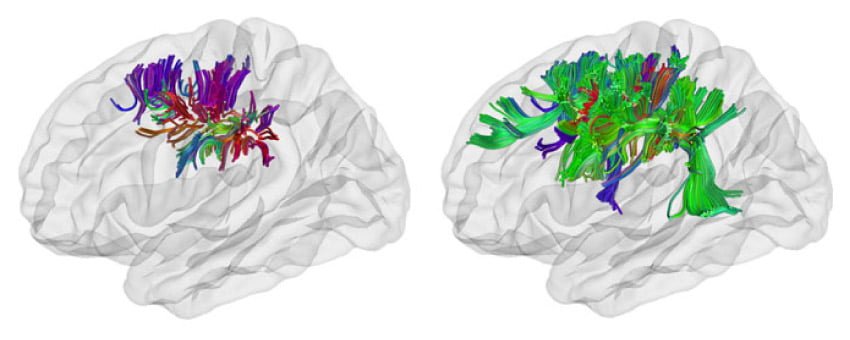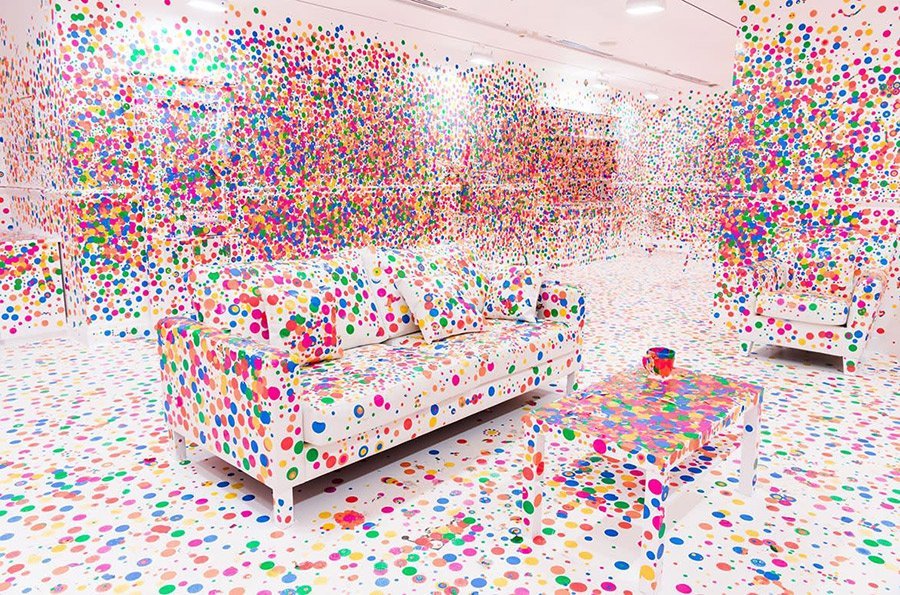This article is in response to the question:
Why do autistic people tend to have disorganized thoughts?

Disorganization
Three factors likely explain why some autistic people experience disorganized thoughts:
- Hyperconnectivity within certain regions of the brain.
- Over-synchronization of 19 identified pairs of brain regions.
- A combination of increased local connectivity and decreased global connectivity.
The autistic brain shows fewer long-range connections but a lot more short-range connections. This means that with every thought, more connections are made, but also more side-steps; it produces nonlinear thought processes. This can have powerful benefits, such as a great associative ability, creativity, and lateral thinking. In my experience, one thought can easily branch off into different thoughts, and the mind doesn’t necessarily always seem to control which path it takes. When your working memory can’t maintain the separate thoughts and their interrelations, this can lead to disorganized thoughts. Yet this disorganization—or different organization—can also be utilized to great effect.
Those thoughts can—in my experience—manifest as “cognitive noise”, which is a constant flux of thoughts of different levels of awareness. So from the subconscious, ideas sort of “bubble up” towards the higher levels of consciousness where it reaches awareness and can be applied. We also have a tendency to cycle and repeat thoughts, and hyperattention to details, the combination of which leads to overvaluation of micro-level events and a propensity to lose oversight. All these factors can contribute to disorganized thought.
Although I won’t go into it in this article, ADHD may also account for some of the things described here. Not only do the two conditions share features, but 37%–78% of autistic people also have ADHD.[1]The comorbidity of ADHD in children diagnosed with autism spectrum disorder (Stevens, Peng & Barnard-Brak, 2016)[2]Identifying comorbid ADHD in autism: Attending to the inattentive presentation (Rau et al., 2020)
Synaptic pruning
Before we get into why the autistic brain can produce disorganized thoughts, let me explain something about brain development and connectivity.
During normal brain development in many mammals—including humans—there is a process where a lot of synapses develop (called synaptic overgrowth), followed by a process of selectively breaking down synapses that aren’t being used enough (called selective synaptic pruning).[3]Synaptic Pruning in Development: A Computational Account (Chechik, Meilijson & Ruppin, 2006) A synapse is a structure that allows a neuron to pass a chemical or electrical signal to another neuron, allowing information to be exchanged between neurons. The extent of interconnectivity of the brain depends on the number of synapses that connect neurons, while specific neurological networks—as well as astrocyte networks[4]Do neurons alone cause consciousness? | ScienceNordic[5]Astrocyte–Neuron Networks: A Multilane Highway of Signaling for Homeostatic Brain Function (Mederos, González-Arias & Perea, 2018)—give rise to particular functioning. Many such networks then give us our mental abilities, behaviors, and personality, and the sophistication of this network leads to higher consciousness.
During infancy, a burst of synapse formation takes place, particularly in the cortex. From birth until adolescence, the synaptic pruning process is preceded by synaptic overgrowth, and thus the neurological network is optimized by removing redundant connections. This is the learning process, and it effectively makes the brain more efficient. Adults have been found to have approximately 41% fewer neurons than newborns.[6]Excess of Neurons in the Human Newborn Mediodorsal Thalamus Compared with That of the Adult (Abitz et al., 2007)

Because less synaptic pruning takes place in autistic brains, a lot of these “redundant” connections remain intact. Since the cortex is involved in many autistic behaviors, a lack of synaptic pruning in this area will affect the extent of these autistic behaviors, as well as abilities. By late childhood, spine density of neurons drops to about half in the neurotypical brain, whereas it drops only about 16% in autistic brains.[7]Loss of mTOR-dependent macroautophagy causes autistic-like synaptic pruning deficits (Tang et al., 2014)

Read more about synaptic pruning here:
Synaptic growth, synesthesia & savant abilities
Overconnectivity
The lack of synaptic pruning means that your neurological network is active in “ineffective” ways; when certain regions are active, adjacent regions tend to activate unnecessarily. In fact, 19 pairs of regions were shown to engage in over-synchronization in autistic individuals compared to controls, and no regions that were less synchronized than in controls were observed.[8]Over-synchronization of brain regions in autism | Integrated Listening Many of these regions are involved in movement and the processing of sensory information, but conversational skills and socializing were also affected. In other words, these over-synchronized areas produce some of the overstimulation autistic people experience, both in sensory processing and general cognition.
Research also shows increased local connectivity and regional coherence in some brain regions, which may be a result of overcompensation for reduced long-range connectivity observed in autistic brains.[9]Connectivity in Autism: A review of MRI connectivity studies (Rane et al., 2015) In other words, there is increased activity on a local level, but a decrease in overall coherence of brain functioning. This may cause autistic people to focus extensively on details, distracting them from the bigger picture.

I said I wasn’t going to talk about the overlap and differences between autism and ADHD, but I do want to report one interesting result. Research from 2014 based on brain scans of 20 children with ADHD, 16 autistic children, and 20 typically developing children (all 7–13 year old) found that there are some structural differences in the most connected brain regions, the rich club networks:[10]Structural and functional connectivity of the human brain in autism spectrum disorders and attention-deficit/hyperactivity disorder: A rich club-organization study (Ray et al., 2014)
- The autistic children showed a disorganized, rich club, with too many weak connections
- The ADHD children showed fewer connections in this same region than controls do
The rich club network is a hub of neural connections that integrates sensory input and cognitive processes from different brain regions, which is crucial to carry out complex yet mundane tasks, such as driving a car.
So autistic people have a cognitive style that privileges local over global or gestalt details,[11]Detail and gestalt focus in individuals with optimal outcomes from Autism Spectrum Disorders (Fitch, Fein & Eigsti, 2015) and show an exceptional ability to hyper-systemizing, hyper-attention to detail, and sensory hypersensitivity.[12]Talent in autism: hyper-systemizing, hyper-attention to detail and sensory hypersensitivity (Baron-Cohen et al., 2009) However, because their brains are much more active than “necessary,”[13]Over-synchronization of brain regions in autism | Integrated Listening the weakly connected brain regions can have a backlog of neural activity.[14]Autism and ADHD: brain connectivity issues not identical | Integrated Listening This can cause drawbacks such as disorganized thoughts, which could impact conversations and social activities.[15]Over-synchronization of brain regions in autism | Integrated Listening
People with ADHD may experience similar issues, but due to fewer connections in the rich club networks, rather than weak connections.[16]Structural and functional connectivity of the human brain in autism spectrum disorders and attention-deficit/hyperactivity disorder: A rich club-organization study (Ray et al., 2014) This is somewhat speculatory, however; I may explore this topic in more detail in a future post.
Associative ability
That overconnectivity has various consequences. Overstimulation is an encompassing aspect, but one aspect of that is the increased associative ability and creative thinking observed in autistic individuals.[17]Study Finds Link Between Autism And Creative Thinking | Catherine Pearson | Huffpost[18]People with autism and learning disabilities excel in creative thinking, study shows | Tracy McVeigh | The Guardian In fact, autistic people have been observed to be up to 40% faster at problem-solving.[19]Autistics Better At Problem-solving, Study Finds | ScienceDaily[20]Enhanced visual processing contributes to matrix reasoning in autism (Soulières et al., 2009) Of course, that extra processing power has to come from somewhere—the hyperconnectivity of certain brain regions.

Associative thinking can be beneficial as a source of creativity, but at the same time, thoughts can be disorganized and jumbled due to all the connections made in the thinking process—some of which may not make sense, while others are so fast and fleeting they barely register. In fact, thoughts can follow each other so fast that it can be hard at times to achieve a linear path in thinking.
Temple Grandin, an American professor of animal science with autism, wrote in her 2009 paper:[21]How does visual thinking work in the mind of a person with autism? A personal account (Grandin, 2009)
My mind is associative and does not think in a linear manner. If you say the word ‘butterfly’, the first picture I see is butterflies in my childhood backyard. The next image is metal decorative butterflies that people decorate the outside of their houses with and the third image is some butterflies I painted on a piece of plywood when I was in graduate school. Then my mind gets off the subject and I see a butterfly cut of chicken that was served at a fancy restaurant approximately 3 days ago. The memories that come up first tend to be either early childhood or something that happened within the last week. A teacher working with a child with autism may not understand the connection when the child suddenly switches from talking about butterflies to talking about chicken. If the teacher thinks about it visually, a butterfly cut of chicken looks like a butterfly.
Cognitive noise
Although not substantiated by research, some autistic people (myself included) have reported experiencing what I came to call “cognitive noise”. I suspect this is a result of the associative ability, combined with a lack of oversight or awareness of certain processes. The result? A constant flux of thoughts, deep down in the subconscious mind, which doesn’t necessarily register to the conscious mind, but does inform it. This constant flux can be a source of creativity, as new ideas constantly bubble to the surface. But at the same time, its constant presence can cause a low-level, yet persistent anxiety, as well as undermine focus. This, also, can contribute to disorganized thoughts.

Repetitive and cyclical thoughts
Autistic people also tend to experience repetitive and persistent thought patterns,[22]A case-controlled study of repetitive thoughts and behavior in adults with autistic disorder and obsessive-compulsive disorder (McDougle, 1995)[23]Restricted, Repetitive Behaviors in Autism Spectrum Disorder and Obsessive–Compulsive Disorder: A Comparative Review (Jiujias, Kelley & Hall, 2017) as well as an increased amount of rumination,[24]Autobiographical memory in adults with autism spectrum disorder: The role of depressed mood, rumination, working memory and theory of mind (Crane, Goddard & Pring, 2011) which is a focused attention on the symptoms of distress and on its possible causes and consequences, rather than on solutions. Additionally, old thoughts may re-enter the mind and become repetitious once more, which is what I would call cyclical thoughts—perhaps more commonly known as intrusive thoughts.

All these thoughts have a tendency to undermine focus and derail the thinking process, as thoughts that may not have much relevance to whatever happens in that moment can become persistent. Of course, this may have its benefits—for one, autistic people tend to consider possibilities and consequences to a much greater degree in order to compensate for their weak theory of mind and to appease their anxiety about unexpected (turns of) events.
Hyperattention to details
The fact that autistic people also tend to find it harder to differentiate between what’s more and less important, or to prioritize thoughts, is another facet. This is not due to an inability, but a disinclination towards global information.[25]Global/Local Processing in Autism: Not a Disability, but a Disinclination (Koldewyn et al., 2014) A positive aspect of this reduced prioritization is that more attention is given to details that others miss and/or do not care about,[26]Talent in autism: hyper-systemizing, hyper-attention to detail and sensory hypersensitivity (Baron-Cohen et al., 2009) and thus more novel considerations are made. However, in the context of a neurotypical world, this disinclination towards global information and a hyperattention to detail (seemingly) amounts to a diminished capacity for hierarchical thinking.
Extra focus on a local level and diminished focus on a global level means that the mind cycles through details more, and tends to overlook the bigger picture. In other words, the autistic mind tends to consider a lot of details while the neurotypical mind thinks in more global and general ways, so the neurotypical mind maintains oversight whereas the autistic mind is prone to overstimulation.

It’s due to the hyper-attention and overvaluation of things that the internal dialogue is never really silenced, and as such the experience of the autistic mind can be one of chaos. Generally speaking, autistic people find it harder to organize their thoughts and their lives.
Decision-making
Studies have additionally found that autistic people experience problems in decision-making more frequently than neurotypicals, and are more likely to report avoidance of decision-making. Time-sensitive decisions and decisions that involved a change of routine, or talking to others, were experienced as particularly difficult. Additionally, the decision-making process was reported to be exhausting, overwhelming, and anxiety-provoking.[27]Decision-making difficulties experienced by adults with autism spectrum conditions (Luke et al., 2011)
Although this is more of a consequence than a cause of disorganized thoughts, it is clear that the internal life of the autistic mind tends to be so rich that it is prone to overstimulation. Because there are so many associations and considerations made, the side tangents can undermine certain tasks, or make them mentally draining.
Conclusion
A few different factors converge to explain why autistic people have an “overly full head” and disorganized thoughts, as well as why we may be scatterbrained, quick to lose oversight, and more prone to overstimulation and dysregulation. All these factors are likely caused by overconnectivity in the brain.
But I should say, disorganized doesn’t necessarily mean detrimental. A lot of us have found ways not only to manage the mental disorganization, but to utilize it! Because disorganization can only happen when there is sufficient information to work with. And something many if not most autistic people are really good at is synthesizing information, making connections, and generating ideas. That process need not be organized. Sometimes, you need a bit of organized chaos to create that spark of genius.
Note also that not everything detailed in this article is necessarily representative of the experience of all autistic people; every autistic person has their idiosyncrasies (talents, challenges, preferences, tendencies, etc.), and the autistic mind is particularly diverse. Read more about that in the post below.
Comments
Let us know what you think!